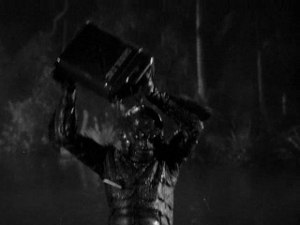
Of all the disappointing third acts in all the trilogies in film this is my measuring stick. Let others pitch a bitch about Ewoks, Bruce Wayne’s mysterious teleportation powers, or whatever the hell it is you all hate soooo much about Godfather III. I always come back to The Creature Walks Among Us, a film almost as depressing as the era that created it. Made for the sole purpose of matching Revenge of the Creature‘s million dollar take, Walks Among Us isn’t the worst third act of a trilogy I’ve seen…but it is the shoddiest, the least-thought-out, and the most mind-bogglingly off-putting. The kind of movie that makes you shout, “What idiot signed off on this?” A movie that dares you to find something good about it, making the presence of a few genuinely good things almost painful. If they weren’t there I could hate the movie outright and maybe then it would stop haunting me.
Sure, 1956 was the year Godzilla first came to America, but most cinephiles choose to remember it (if at all) as the year of The King and I or The Ten Commandments. Big, loud, annoyingly long epics were the blockbusters of their day and it’d be seven years yet before Cleopatra finally proved their day was done. Everyone else’s budgets shrank to accommodate their excesses and Universal’s monster movies were no exception. The studio that basically built Horror as a genre now contented itself releasing stuff like The Mole People…and this. Demonstrating they’d learned nothing from the 1940s.
Once again: a rushed production plus a reduced budget equals a bad movie. A string of bad movies equals a franchise no one remembers, save as a punchline. The problem’s exasperated when your title character is so one-note, even compared to his elder brothers in the Universal stable. Dracula usually wanted blood. Werewolves usually want cures. Mummys usually want some artifact or the reincarnation of their dead girlfriend. Frankenstein’s monster just wants to be left alone…something he and the Gillman have in common. All of Gilly’s movies hinge on invasions of his domain by hairy man-animals and their hot girlfriends…but unlike Frankenstein’s monster, you can’t keep bringing the Gillman back to life.
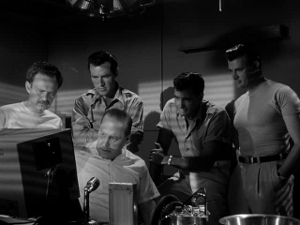
Once was pushing it. Twice is ludicrous…especially since the Creature faced down an entire Florida State Trooper firing squad last time. Yet somehow Walks Among Us finds him in the Everglades, hunted once again by a nefarious team of Scientists With Interpersonal Issues. The first film created what human drama it could by making those Issues dynamic. The second failed to do that and so failed as a whole. This third entry fails because the Scientists involved are all horrible people. I finished the opening scenes happily anticipating their demise. As with all bad horror movies of this period, that demise’s too slow to come, and concludes too quickly.
On paper, this thing looks pretty solid for a second sequel. The Creature‘s original writer, Arthur A. Ross, returns, and I can tell as soon as the characters begin speaking. They’re much stronger than the fools peopling Revenge. Director John Sherwood’s one of those guys who punched a clock as an assistant director since the mid-30s, finally getting his shot at the big chair in ’56 with this and a Western called Raw Edge. The stuff he does here is…not better than Jack Arnold’s work…but certainly more traditional, and lacking Arnold’s documentary appreciation for kick-ass landscapes. It’s distinctly style-free but not bad by any stretch of the imagination.
So I can’t blame the writer or the director for this movie’s failings. Can I reasonably blame the cast? No. They’re all solid, B-movie pros with long resumes before and after this. Fuck’s sake, our two males leads are from This Island Earth and that counts for a lot. Our female lead’s from Kiss Me Deadly and that counts for even more. The supporting players are all strong, too, so what keeps me from getting into all this? Why am I alienated from this movie before the twenty minute mark?
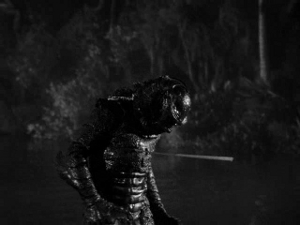
For one thing, these Everglades are not our Everglades. According to this film, the Everglades are hundreds of feet deep and filled with Creature-friendly caves. Instead of being about nine feet deep and filled with alligators and mob informants. For another, this is Universal World, where they hand out doctorates to any asshole who can make a stirring speech about Man’s Place in the Universe and What It’ll Take to Advance Him Further.
Leading the expedition, we find Dr. William Barton (Jeff Morrow), a surgeon obsessed with capturing the Gillman. Later he’ll make a Dramatic Speech about using knowledge gleaned from Gilly to accelerate human evolution and maybe get this roadshow into space. Fine enough…but what makes him think to look for a secrets of evolution in the Gillman? Especially after the first film made such a big deal about the Creature being an evolutionary dead end? Obviously, I’m the only one paying attention. It’s not like the writer of the first film returned for this installment…oh, wait…
Joining Dr. Barton are his wife, Marcia (Leigh Snowden), geneticist Dr. Thomas Morgan (Rex Reason) and local guide Jed Grant (Gregg Palmer). There are at least two other characters, Dr. Borg (Maurice Manson) and Dr. Johnson (James Rawley), but they’ll do little beyond cut bandages, explain what sonar is to an obviously dumb audience, and (in Borg’s case) add our biological and technological distinctiveness to their own. Barton, Marcia and Morgan absorb most of the film’s attention, with Jed occasionally popping up to remind us just how ugly our fellow man can be.
Over the course of the film we learn that, apart from being crazy, Dr. Barton’s also suffering from alcohol-assisted paranoid delusions, mostly revolving around his wife. In one of the film’s too-frequent quiet moments, Marcia reveals they got hitched when she was the ripe old age of seventeen. This was ten years before the events of the film, making Marcia exactly as old as her actress (hey – it’s more of a novelty than you’d think, especially in a culture like ours, that worships youth while ghettoizing the youthful). I’ve no idea how old Dr. Barton’s supposed to be but, going by his actor’s age, I’m forced to conclude he’s a fucking creep. A grown-ass man who still combed highschools for hot dates while he was pushing forty. Sweet Jey-zus!
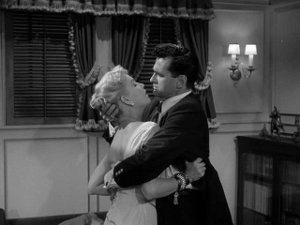
And this asshole’s our protagonist! He bankrolled the Creature-catch and his massive California ranch serves as the Gillman’s final home away from home. Barton’s the villain of a Steinbeck novel: a jumped up member of the SoCal ladafundia who spent his whole life taking what he wanted ‘cuz he could. Not knowing what to do with most of it, he locks it away in his sweet house, where he can keep an eye on it, because he can’t trust it…I’m sorry, I mean “her”…to be out of his sight for five seconds.
Dr. Barton (to his wife): Don’t ever try to leave me…don’t ever try to make a fool of me.
This he says with enough veiled menace to make me question why Marcia agreed to go anywhere with him. Never mind accompanying her paranoid android on a boat trip with a load of other men, all of them existential threats to his ego. You’d think a week with him out of the house would move Marcia to recreate (or pre-create) the dance scene from Risky Business, only with actual old time rock n’ roll, rather than Bob Segar’s tribute to it.
Marcia’s not exactly a prize after ten years of not-so-benign neglect from a husband who treats her like his daughter…which she could very well be. Twenty bucks says someone made that mistake at some point in their relationship…and Barton found a way to blame her for it, because that’s just how he rolls. After ten years in this loveless hell, Marcia’s basically a non-character: vacillating between cowed housewife and the impulsive teenager she probably was when she and Barton first met. Neither Marcia is very interesting, though I get the sense either could be if the movie were a little longer…or if it used its time more efficiently.
Marcia: “You know, taking chances isn’t just a man’s privilege.”
Dr. Morgan: “Trying to kill one’s self isn’t either.”
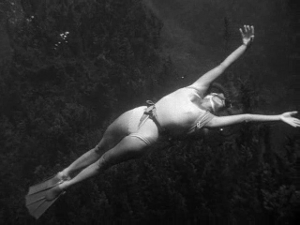
For example: she insists on accompanying Dr. Morgan and Jed Grant’s first Creature-hunting dive because…well, she’s bored. When Jed tries to scare her off by explaining the dangers of nitrogen narcosis (or “rapture of the deep”), Marica waves that away. She’s one of those people who always knows when they’ve had enough. (Ya know: lushes.) After seven minutes of scuba diving, she gets the rapture, forcing the boys to scrub their mission and haul her ass to the surface.
Obviously, this last bit of stupid is a contrived excuse for Leigh Snowden to “frolic” around underwater in one of those lily-white, one-piece bathing suits that’re as much of a series hallmark as Ol’ Gill. And that’s why I dislike this film: most of it’s filler, the time wasted by people talking to (or at) each other, or us. What remains is either padded out or outright redundant. Like our one and only underwater scene, or all the maddeningly monologue-heavy conversations that follow it.
That the Creature will be captured is a foregone conclusion. But unlike last time, the capture sequence is pretty damn awesome. It’s my favorite part of Walks Among Us – the part that most resembles Moby Dick. By now both man and Gillman are familiar with each other’s tactics. So after half an hour of faffing, a surprisingly tense (in that I’m surprised there’s any tension in this film at all) cat and mouse game breaks out, with man and Gillman luring each other into a trap they both feel will favor their strengths. The humans have lights, guns and knock-out harpoons. The Creature has brute strength and a home field advantage once the river narrows, forcing Our Humans into a rinky-dink motorboat. Ol’ Gill almost triumphs, bless him, only passing out due to wounds sustained form accidentally dousing himself in gasoline.

The fire burns away the Creature’s outer scales, exposing a softer, second skin, and destroying his gills. Drs. Barton and Morgan perform a tracheotomy to aid the creature’s back-up lungs and accidentally trigger one of those instant, extra-fast mutations that only happen in movies. The Creature emerges looking like a doctor from that Twilight Zone episode, Eye of the Beholder, except more symmetrical and, therefore, less ugly.
Despite this, I surprised myself with how much I enjoyed this Creature make-up. His mouth is smaller, but so are his eyes – meaning, for the first time in three films, we can actually see the eyes of the actor playing our creature, Don Megowan. Thankfully, Megowan has the power to emote more with his eyes than the rest of this cast can manage with their entire bodies. Making his the film’s best performance. Even though the script undermines their efforts at every turn, Megowan and our director try their damnedest to re-invest the Creature with real menace. Making him look more human turned out to make him look more threatening, because real eye balls are far more unsettling than the glassy, fish-orbs of the past.
But everything else the made the Creature unique or interesting’s stripped away, thanks to Barton and his enablers. Without his aquatic nature and antisocial disposition, ol’ Gill’s just a dude in some puffy shirts. At best, this should’ve been a Frankenstein movie. It’s got all the hallmarks. Both monsters are called “the creature” by their credit sequences, both have an unnatural attraction to much-suffering blondes, and both get an involuntary crash course in how much humanity sucks.
Dr. Morgan: You think of everything, don’t you, doctor?
Dr. Barton: Yes.
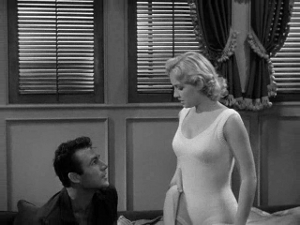
Rex Reason plays the only decent human being in this world, but he plays it so flatly I long for the nuanced performance he gave in This Island Earth. I’m not even kidding. He’s the emotional heart of the film, and its psychological exposition deliverer, yet he has one tone of voice and all of two facial expressions.
The same’s true of Jed Grant, the other side of the humanity coin: a lecherous man who wants to “be friends” with Marcia in the worst possible way. He comes on hard and takes her unwillingness to roll over and spread the way most assholes do: as a sign she’s playing hard to get.
Marcia: Being your friend won’t solve my problems. Can’t you understand that?
Jed: No.
Only a stiff-arm from the Creature saves Marcia from any more of Jed’s tender attentions. But having been cowed, of course, Marcia says nothing about Jed’s attack to anyone. That way the whole sad lot of them can cart the Creature back to Barton’s ranch – and the Creature Corral he’s built off the back porch.
Morgan and Barton have a very interesting conversation while looking in on the Creature through some two-way glass. Barton tries his best to have a Guy Moment and jaw over his wife’s supposed infidelities (i.e., those times she dares talk to another human with a penis). Morgan tries to steer away from this uncomfortable subject matter, but Barton won’t let it go. So he starts speaking hypothetically. “About the Creature.” Riii-iiight…
Barton: Imagine how often love is returned with hate and…loyalty is returned with infidelity.
Morgan: Is that a proven fact?
Barton: Oh, facts, Dr. Morgan, I only deal in facts. In reality. Only that.
Morgan: We make our own reality sometimes….
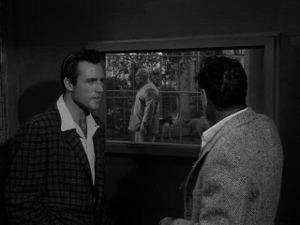
It’s a wonderfully perverse picture of masculinity in the mid-50s. Here are two grown-ass men, now, incapable of addressing a situation head-on because neither one of them is emotionally mature enough to handle it. Not even the one with the psychology doctorate! Six-to-eight years of school and the best he can do is offer some vague metaphors and veiled threats about societal retribution. But, from one fake doctor to another, let me let you in on a little secret, Morgan: when a dude all but tells you, “I’ve given serious thought to murdering my wife. She a cheater!” the only correct response is, “Dude, calm the fuck down – you’re talkin’ crazy talk.” One of the many, many, many possible incorrect response looks like this:
Morgan: If [the Creature] thinks all men are his enemy, if he can’t see things the way they are, instead of the way he thinks they are, he lives in terrible fear…The same holds true for man. If man, or animal, becomes too terrified to think he resorts to violence. And in the animal world it’s called The Law of the Jungle. But when it happens to human beings it’s name is ‘murder.’ [Dramatic music cue for emphasis!]
More than either of its predecessors, I feel the writer and director really wanted us to identify with the Creature and share his plight. Like him, we’re trapped at Barton’s palatial mansion, staring in on the lives of four losers who could’ve been right out of a Bronte novel if they weren’t so boringly American, or so mid-20th century. After an hour and change of constant disappointment, we celebrate the Creature’s escape from his pen, both because it signals the end of this movie and because it leads to one of the greatest room-trashing sequences in the history of cinema. Charles Foster Kane would be proud. It’s an eleventh-hour shot of adrenaline that shows me what this could have been. Didn’t the title promise something about walking among us? I guess The Creature Walks Among Some Uptight, Repressed Assholes would’ve been too vulgar, and damn the truth in advertising laws.
Who wants to see the Creature walking, anyway? He was at his most interesting back in that black lagoon. Importing him to a (cheaper, more recognizable) modern world robs him of too much. In the end, we nod in agreement as he walks back into the sea, tuckered out from another bought of vengeance.
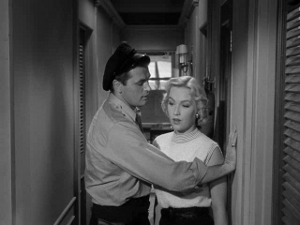
I like to think he’s as tired of us at this point as we, out here in Audience Land, are of him and these damn sequels. This one’s better than Revenge but that’s not a hard thing to be…and it’s a difference of degrees. If you’d like to see a once-promising horror franchise run itself down like an old watch The Creature Walks Among Us is defiantly your film. Everyone else: skip back to the original. Or do what I do and jump forward to one of the many, many, many other aquatic monster movies it inspired. These two sequels do nothing but disappoint and depress.
![]()
![]()
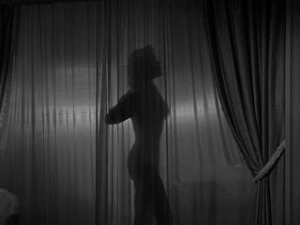

AGREE AGREE AGREE.
Lord I hate this movie. Also, thanks for that final shot.
You’re welcome, as always.
But what about the last 90secs or so…as he come over the hill, bleeding and stares at the ocean? Probably for the first time.
Familiar yet different. Water yet violent.
The ending has haunted me since I first saw it as a kid in the 50’s.
I would have had him do another evolutionary leap and finally escape to a new home.